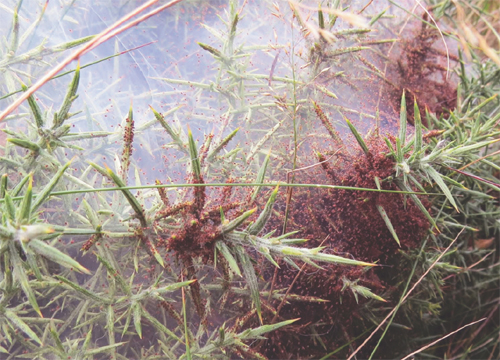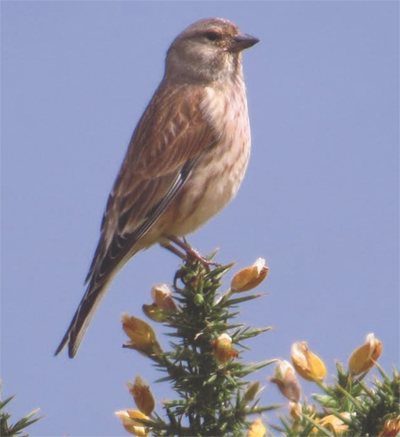| October
/ 2017 - Michael Ryan
|
| Although
a tragic little event
it was lucky that it was Freda, a friend of Lucy, who spotted the tiny
red squirrel on the ground not far from the Dalkey Hill car park. It
was rolling around trying to right itself and it seems likely that it
had fallen from the tree but it was a stroke of luck that Freda found
it before one of the many dogs that roam the hill came upon it. Freda
took it home, wrapped it up warmly in a darkened box and consulted that
very useful website irishwildlifematters.ie. This website gives detailed
practical help in assessing if an animal needs help, how to handle it
and how to care for it as well as listing various individuals and organisations
who specialise in treatment of our native creatures. It actually took some milk that Freda offered it and the little creature slept soundly that night. It took some more milk the following morning but as she was putting it in the car to take it to the vet she saw that the poor little creature had passed away. She said it had been dragging its back legs and it possibly had spinal injuries so its future wasn’t very hopeful anyway and at least it was fortunate that the person who had found it had made its last few hours peaceful and stress free. I had the body overnight before passing it on to the Squirrel Project researcher. Freda had previously said on the phone it was very young and fitted in the palm of her hand but I was still surprised when I saw how small the body was. |
 Young Red on Dalkey Hill Photo: Michael Ryan |
|
|
Although
it had well developed ear tufts and a bushy tail its claws looked very
short and I wondered had the squirrel actually been out and about moving
through the trees or had it actually fallen out of a dray before it
was ready to leave by itself. Some years ago we’d seen a adult
red squirrel slip and fall from a branch but luckily for it there were
a number of leafy branches underneath it which broke
its fall and it just scampered off after landing. The agility of squirrels when moving through trees is spectacular but it’s a skill that has to be learned and one mistake can be fatal. We’d seen reds with nesting material in spring this year and had seen a female red squirrel on Killiney Hill some weeks before which had prominent teats and tummy so we presumed she was pregnant but the injured red was the first proof there had been successful breeding on the hills this year. It was very unfortunate it had died but just over a week later we spotted a group of three reds feeding in Beech and Scots Pine. Two were adults but the first of the group we spotted had no earclips so we knew it was another squirrel born this year so there’s at least one of a new generation of squirrels on the hills. |
||
|
|
 Gorse Spinder mite on Kiliney Hill Photo: Michael Ryan |
| Mighty
Mites. Near the obelisk we noticed
a number of gorse bushes shrouded in what looked like spiders web silk.
Initially I thought it might be due to a moth. A few years ago in Estonia
we’d came across some small trees completely covered in swathes
of web. Although mid-summer there were no leaves on the trees and the
bare branches wrapped in their gray translucent shroud looked quite
sinister. Later we found out the ‘silk’ was produced by
a moth, possibly the Small or Spindle Ermine, to protect the caterpillars
it had lain on the tree and in fact it didn’t do the trees any
harm and the leaves would grow back the following year. So initially we thought the web on the gorse on Killiney hill might be full of caterpillars, but it wasn’t. Looking closely we saw thousands of tiny red particles in the silk and then noticed some of them were actually moving. They looked like tiny spiders and subsequently I discovered they were the gorse spider mite (Tetranychus lintearius). Aptly named, since it is host specific, only feeding on gorse, the mites damage the gorse cells tissue when they feed on it, even stopping the plant flowering and stunting the branch growth. I found this out by a Google search but the search results for gorse spider mite generally refers to it in its context of a very important biological pest control of gorse. In Ireland gorse is a great habitat for insects, the flowers providing early spring nectar for many insects and is a good nesting plant for many birds though it can be a nuisance when it is maliciously set alight. I hadn’t known that our native gorse when introduced to other continents including Australia and North America as a hedging plant or to feed livestock becomes a notoriously invasive weed, very difficult to eradicate, out-competing native plants and ruining habitats. It has taken over vast areas of grassland in Sri Lanka and is out competing native flora in Chile. But its most serious threat is its predilection towards burning and the dangers are accentuated when it is growing in very dry hot regions. One site refers to the fact it was instrumental in a ferocious fire in the town of Bandon in Oregon in 1936. An Irish immigrant had introduced gorse into the town 63 years before and it had spread around the town to the extent that when a wildfire broke out nearby it raged through the gorse destroying the town and resulting in the death of ten people. The gorse spider mite when introduced on to bushes won’t totally eradicate the gorse but it can substantially slow down its growth to manageable levels where it can be controlled. We went back to check the gorse bushes near the obelisk a few weeks after and the webs and mites were still there. I hadn’t expected to see any change in the bushes but the gorse bushes supporting the mites were definitely bleached looking, much paler than any other adjoining gorse so evidently a multitude of munching mites were having an effect. |
DALKEY HOME PAGE | DALKEY COMMUNITY COUNCIL | DALKEY HERITAGE COMPANY | CANNONAID



